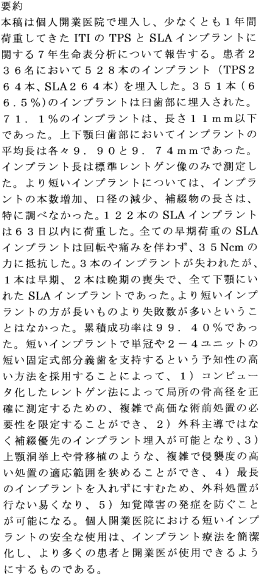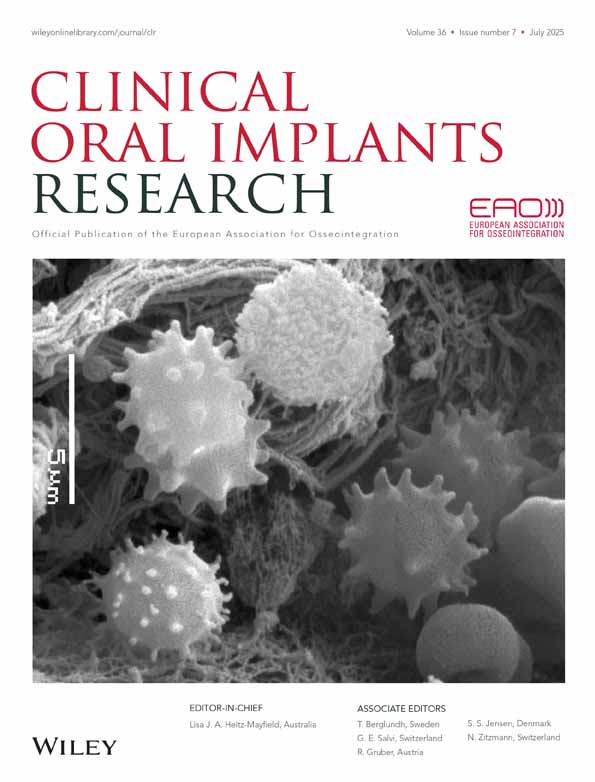A 7-year life table analysis from a prospective study on ITI implants with special emphasis on the use of short implants
Eine Life Table Analyse einer prospektiven Studie an ITI Implantaten über 7 Jahre mit speziellem Schwergewicht bezüglich der Verwendung von kurzen Implantaten. Resultate aus einer Privatpraxis.
Results from a private practice
Abstract
enAbstract: This paper reports on a 7-year life table analysis on ITI titanium plasma-sprayed (TPS) and sandblasted and etched (SLA) implants placed in a private practice and loaded for at least 1 year. In 236 patients, 528 (264 TPS and 264 SLA) implants were placed, 351 (66.5%) implants rehabilitated the posterior region and 71.1% implants were ≤11 mm. In the posterior mandible and maxilla, the mean implant length was 9.90 and 9.74 mm respectively. Implant length was determined through standard radiographs only. Increase of the number of implants or reduction of the width or the length of the rehabilitations was not specifically sought for the shorter implants. One hundred and twenty-two SLA implants were loaded within 63 days. All early loaded SLA implants resisted the applied 35 N cm without rotation or pain. Three implants failed, one early and two late failures, all were SLA implants placed in the mandible. Shorter implants did not fail more than longer ones. The cumulative success rate was 99.40%. The predictable use of short implants supporting single crowns and small fixed partial dentures of 2–4 units supported by two to three implants permitted (1) restricting the need for sophisticated and expensive presurgical procedures aimed to determine precisely the available bone height by computerized radiographic methods, (2) the placement of prosthetically driven restoration instead of surgically driven ones, (3) reducing the indications span for complex invasive procedures like sinus lift and bone grafting procedures, (4) facilitating the surgery, without attempting to place the longest implant and (5) avoiding the occurrence of sensation disturbance. The safe use of short implants in a private practice should make implant therapy simpler and accessible to a higher number of patients and practitioners.
Résumé
frCe manuscript rapporte une analyse sur sept ans d'implants ITI® TPS et SLA placés dans un cabinet privé et chargés pendant au moins une année. Chez 236 patients, 528 implants (264 TPS et 264 SLA) ont été placés, 351 (66,5%) d'entre eux pour reconstruire la région postérieure et 71,1 étaient ≤11 mm. Dans les parties postérieures de la mandibule et du maxillaire la longueur implantaire moyenne était respectivement de 9,90 et 9,74 mm. La longueur de l'implant était déterminée à partir uniquement de radiographies standards. L'augmentation du nombre d'implants ou la réduction de la largeur ou la longueur des reconstructions n'étaient pas spécifiquement recherchées pour les implants les plus courts. Cent vingt-deux implants SLA ont été mis en charge avant 63 jours. Tous les implants SLA avec mise en charge précoce ont resistéà la force de 35 Ncm appliquée sans rotation ni douleur. Trois implants ont échoué: 1) de manière précoce et 2) plus tard, tous étaient des implants SLA placés dans la mandibule. Les implants les plus courts n'avaient pas davantage d'échec que les plus longs. Le taux de succès cumulatif était de 99,40%. L'utilisation prévisible des implants courts portant des couronnes uniques et des petites prothèses fixées de deux à quatre unités supportées par deux à trois implants permettait 1) de réduire la nécessité de processus préchirurgicaux sophistiqué et cher visant ‘a d”terminer précisemnentla hauteur osseuse disponible par des méthodes radiographiques avec ordinateur, 2) le placement de restaurations axées sur la prothèse plutôt que sur la chirurgie, 3) de diminuer la portée des indications des processus invasifs complexes comme l'épaississement du plancher buccal et les processus de greffe osseuse, 4) de faciliter la chirurgie sans essayer de placer l'implant le plus long, 5) d'éviter l'apparition de troubles de sensation. L'utilisation sũre d'implants court dans une pratique privée pourrait rendre la thérapie plus simple et accessible à un polus grand nombre de patients et de praticiens.
Zusammenfassung
deDiese Arbeit berichtet über eine 7 Jahre Life Time Analyse von ITI TPS und SLA Implantaten, welche in einer Privatpraxis gesetzt wurden und für mindestens 1 Jahr unter Belastung standen. Bei 236 Patienten wurden 528 Implantate (264 TPS und 264 SLA) eingesetzt, 351 Implantate (66.5%) dienten der Wiederherstellung der posterioren Region und 71.1% der Implantate waren 11 mm lang. In der posterioren Mandibula bzw. Maxilla betrug die mittlere Implantatlänge 9.9 bzw. 9.74 mm. Die Implantatlänge wurde nur auf Standardröntgenbildern bestimmt. Bei Rekonstruktionen mit kurzen Implantaten wurden nicht speziell mehr Implantate verwendet oder die Breite oder die Länge der Rekonstruktionen reduziert. 122 SLA Implantate wurden innerhalb von 63 Tagen belastet. Alle frühbelasteten SLA Implantate widerstanden den applizierten 35Ncm ohne Rotation oder Schmerzen. 3 Implantate zeigten Misserfolge, einen Früh- und 2 Spätmisserfolge. Es handelte sich dabei ausschliesslich um SLA Implantate, welche im Unterkiefer eingesetzt worden waren. Kurze Implantate zeigten nicht mehr Misserfolge als lange. Die kumulative Erfolgsrate betrug 99.4%. Die Verwendung von kurzen Implantaten, welche Einzelkronen und kleine festsitzende Brücken mit 2–4 Einheiten auf 2–3 Implantanten trugen, erlaubte, 1) die Notwendigkeit von komplizierten und teuren prächirurgischen Abklärungen zur genauen Bestimmung der zur Verfügung stehenden Knochenhöhe durch computerisierte radiologische Methoden zu beschränken, 2) die Platzierung von prothetisch diktierten Rekonstruktionen anstelle von chirurgisch diktierten Rekonstruktionen, 3) eine Reduktion der Indikationsbreite von komplexen invasiven Prozeduren wie Sinuslift und Knochentransplantationen, 4) eine Erleichterung der Chirurgie indem nicht ein möglichst langes Implantat gesetzt werden musste, 5) das Auftreten von Sensibilitätsstörungen zu vermeiden. Die sichere Verwendung von kurzen Implantaten in einer Privatpraxis sollte die Implantattherapie einfacher machen. Dadurch sollte die Behandlung mit Implantaten einer grösseren Anzahl Patienten und Praktikern zugänglich werden.
Resumen
esEste estudio informa sobre un análisis de un cuadro de vida de implantes ITI TPS y SLA colocados en una consulta privada y cargados durante al menos un año. Se colocaron 528 implantes (264 TPS y 264 SLA) en 236 pacientes, 351 implantes (66.5%) rehabilitaron el maxilar posterior y el 71.1% de los implantes fueron ≤11 mm. La longitud media de los implantes en la mandíbula posterior y el maxilar fue de 9,90 y 9.74 mm respectivamente. La longitud del implante se determinó solamente a través de radiografías. No se buscaron específicamente incrementos en el número de implantes o reducción en la anchura o longitud de las rehabilitaciones para los implantes cortos. Se cargaron 122 implantes dentro de los 63 días. Todos los implantes SLA cargados tempranamente resistieron la fuerza de 35 Ncm aplicada sin rotación ni dolor. 3 implantes fracasaron, uno tempranamente y 2 tardíos, todos fueron implantes SLA colocados en la mandíbula. Los implantes mas cortos no fracasaron más que los implantes largos. El índice acumulativo de éxito fue del 99.4%. El uso predecible de implantes cortos soportando coronas unitarias y pequeñas prótesis fijas parciales de 2–4 unidades soportadas por 2–3 implantes permitieron, 1) restringir la necesidad de procedimientos quirúrgicos sofisticados y costosos con la intención de determinar con precisión la altura de hueso disponible por medio de métodos de radiografías computarizadas, 2) la colocación de restauraciones orientadas prosteticamente en vez de quirúrgicamente, 3) reducir el abanico de indicaciones para procedimientos complejos invasivos tales como procedimientos de elevación del seno e injertos, 4) facilitar la cirugía, sin intentar colocar el implante mas largo, 5) evitar la aparición de sensación de molestia. El uso seguro de implantes cortos en una consulta privada debería hacer el tratamiento de implantes mas simple y accesible para un mayor número de pacientes y profesionales.





